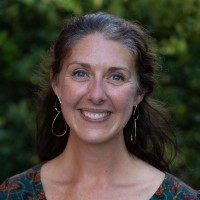 RMHF is excited to continue our year-long “Voices from the Region” feature series, focused on providing space for elected officials, nonprofit leaders, partners, and others to share their diverse perspectives about the role of health, ethnic and racial equity in the Richmond Region.
RMHF is excited to continue our year-long “Voices from the Region” feature series, focused on providing space for elected officials, nonprofit leaders, partners, and others to share their diverse perspectives about the role of health, ethnic and racial equity in the Richmond Region.
By posing the same five questions to each person, we aim to capture critical insights and important ideas about the ways in which we are helping to meet this foundational obligation and how we can improve as a community.
Kate Ayers is the Executive Director of ReEstablish Richmond, a local organization dedicated to connecting refugees and new immigrants to the resources needed to establish roots, build community, and become self-sufficient.
ReEstablish Richmond has been a longtime partner of Richmond Memorial Health Foundation (RMHF), and considering the dramatically evolving national landscape and uncertainty driven by new cuts and policies enacted by the federal government, we thought Kate’s voice would serve as an important contribution to the ongoing discussion about health, ethnic and racial equity.
When asked about her own personal definition of health, ethnic and racial equity, Kate not only described the issues themselves, but what it would look like when racial equity exists, and what we must commit to doing as a society in order to effectively enact these policies.
“Health equity means ensuring that everyone has access to the tools and resources they need to achieve their best possible health,” she said. “Racial equity exists when a person’s race no longer predicts their outcomes in areas like health, education, housing, and employment. Putting equity into practice means recognizing and addressing the systemic barriers that prevent some individuals and communities from thriving at the same rate as others.”
In her capacity as the Executive Director of ReEstablish Richmond, Kate explained that in order to pursue health, ethnic and racial equity efforts, it all starts with listening and using that feedback to create welcoming, inclusive spaces for clients, staff, and others to share their lived experiences. It’s these conversations, Kate maintains, that help unearth the true impact of inequities and reveal the blind spots we have that may make it difficult to truly see the issues that make it difficult for people to thrive.
And to truly see these issues, Kate says, requires a willingness to be vulnerable.
When discussing what she views as the biggest challenge facing the community that impedes progress towards health, ethnic and racial equity, Kate outlined a few other requirements.
“Achieving equity requires time and resources,” she said. “It means prioritizing people over profit, which runs counter to dominant cultural norms.”
What then, is keeping us from adopting some of these large-scale societal changes? What remains an enduring challenge?
“When the dominant culture fails to recognize the importance of racial equity,” Kate said, “or doesn’t value the effort needed to move this work forward.”
Despite these ongoing issues, Kate shared that she has witnessed meaningful progress in the community since the early 2010s, specifically in the evolution of how public and private partners think about health and racial equity.
“There’s been growing awareness and intentional action, especially around language access and culturally responsive services,” she said. “This progress is most visible in how governments, school systems, and organizations are partnering with community leaders who value equity work.”
Kate also mentioned the healthcare sector as a longtime leader in health and racial equity efforts. She explained how members of this crucial sector have continuously pushed for increased access to language services for patients, transportation services, and the adoption of culturally-appropriate care.
Kate also identified progress being made at perhaps less obvious places like the DMV. While the DMV may not appear like an organization on the frontlines of health and racial equity, they serve so many Virginians and have taken important steps to improve access on a variety of fronts.
“One powerful example is ReEstablish Richmond’s advocacy with the DMV,” Kate said. “Our efforts led to the DMV improving language access and making their services more accessible for immigrant communities across the state.”
When asked to identify the one thing she would change in the community to improve health, ethnic and racial equity outcomes, Kate mentioned the need for universal access to healthcare. In keeping with her other answers, she also explained that once this step is taken, it will set the stage for additional progress in other areas.
“Once that foundation is in place,” Kate said, “the next step is to increase diversity within the healthcare workforce and invest in community health workers. These workers play a vital role in building trust and bridging gaps between health systems and the communities they serve.”
In that same vein, Kate pointed out that another systemic challenge anyone engaged in health, ethnic and racial equity work faces is the reality that our institutions are built around an exceedingly narrow view of what “health” is, which often rejects cultural, generational, and other key differences within our communities.
“We need to create space for and value these diverse approaches,” she said. “True equity requires not just access, but flexibility, humility, and a willingness to honor different ways of knowing and being well.”